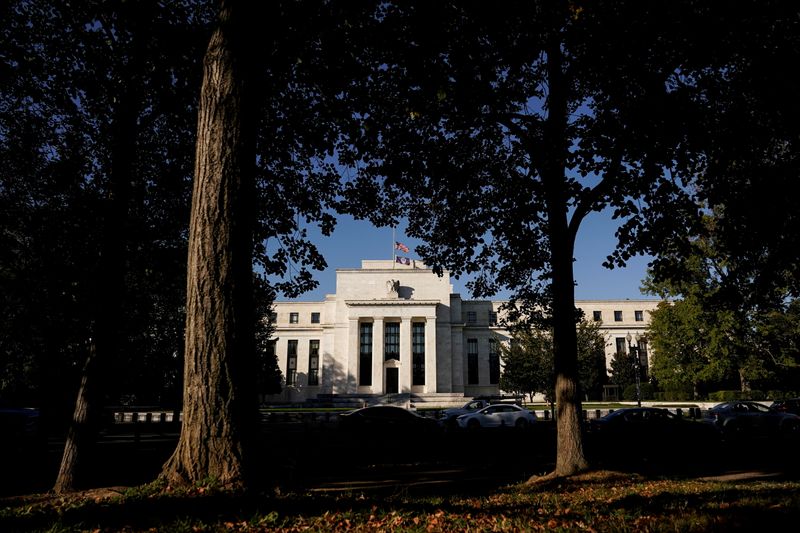(Bloomberg) -- The Federal Reserve will unveil details of its likely plans to shrink its massive balance sheet with the release of minutes of the U.S. central bank’s March meeting, as policy makers confront the highest inflation in four decades.
Fed Chair Jerome Powell promised “a more detailed discussion” of the $8.9 trillion balance sheet laying out “pretty much the parameters of what we’re looking at,” in his comments during a press conference following the March 15-16 Federal Open Market Committee meeting. Officials at that meeting raised interest rates for the first time since 2018.
The minutes, published at 2 p.m. Washington time Wednesday, will probably show a much faster pace of reduction than the last time it conducted this exercise between 2017 and 2019. This could include details on monthly caps that increase over time to govern the roll off of the Fed’s holdings of maturing Treasuries and mortgage-backed securities, which officials bought aggressively to shield the economy as Covid-19 spread.
Governor Lael Brainard said Tuesday that the process could start as soon as May and go considerably faster than in 2017, when they rose over the course of a year to a maximum monthly roll off of $50 billion combined.
Officials only halted bond purchases last month as surging inflation accelerated plans to reduce the balance sheet, viewed as a passive way to tighten monetary policy that supplements increases in interest rates.
“They will have a full-on plan,” said Stephen Stanley, chief economist at Amherst Pierpont Securities LLC. “They want to set the table for being able to make an announcement in May. Because inflation is so high, it has become an urgent issue.”
Economists say the caps on runoff could total roughly $100 billion monthly, allowing around $1 trillion in reductions per year. JPMorgan Chase & Co.’s Michael Feroli estimates caps at $60 billion for Treasuries and $30 billion for MBS, while Evercore ISI’s Krishna Guha sees $50 billion and $30 billion and Deutsche Bank expects $60 billion and $45 billion.
The Fed could also allow runoff of Treasury bills right away, not counting toward the caps.
What Bloomberg Economics Says
- “We expect the discussion in the minutes to indicate that policy makers are close to finalizing the balance-sheet run-off plan.
- The minutes will contain multiple run-off scenarios, ranging from slower to faster. Most participants may be drawn to a gradual path with passive run-off, given uncertainty over possible effects of the balance-sheet move.
- The scenario garnering most support will likely be one where the stock of assets approaches the pre-pandemic level in three years -- so with terminal caps at between $80 billion-$100 billion per month.”
-- Anna Wong, Yelena Shulyatyeva, Andrew Husby and Eliza Winger, economists
For the full note, click here
With inflation the highest since 1982 and the Fed having recent experience with runoff, reaching the maximum levels could happen relatively quickly.
It’s likely to be “a very short phase-in period of just two months,” said Aneta Markowska, chief U.S. financial economist at Jefferies LLC. “ There is really no need for a long phase-in.”
There’s a high degree of uncertainty over the economic impact to the balance sheet cutbacks. Powell said the reduction “might be the equivalent of another rate increase.” The FOMC has committed to using rates, not assets, as its main monetary policy tool.
The goal will be to have runoff to be “more of a background measure,” Grant Thornton chief economist Diane Swonk said. “They really prefer to use rate hikes to be the primary tool to tighten. The Fed will leave door open to adjustments in balance sheet if necessary but would like focus to be on the rates for now.”
Downsizing assets will be the Fed’s latest maneuver to try to cool inflation pressures. Policy makers in March raised their key rate by 25 basis points to a target range of 0.25% to 0.5% after two years of holding borrowing costs near zero to insulate the economy from the pandemic.
In the Fed’s so-called dot plot of quarterly interest-rate forecasts, officials’ median projection was for the benchmark rate to end 2022 around 1.9% and then rise to 2.8% in 2023.
While the balance sheet details will be the focus of the minutes, investors will also scrutinize the discussion of the past meeting for clues on whether the Fed will raise rates by a half point in May. Powell said on March 22 that he was open to a larger hike if needed at the May meeting and other policy makers have voiced the same sentiment since then.
The minutes don’t name names -- opting instead to characterize how many officials voiced one side of an argument or the other -- but could still provide a clear sense if there was general support for such a move at the time of the meeting. And any backing among officials for a half-point move could have increased since then.
“I think there will be a discussion of a 50 basis point hike, with at least “several” -- or “many” -- participants open to such a move in the coming months,” Markowska said.
©2022 Bloomberg L.P.
